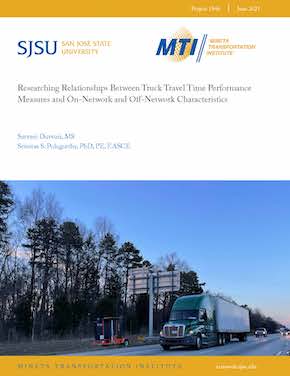- 408-924-7560
- mineta-institute@sjsu.edu
- Donate
Researching Relationships Between Truck Travel Time Performance Measures and On-Network and Off-Network Characteristics
Trucks serve significant amount of freight tonnage and are more susceptible to complex interactions with other vehicles in a traffic stream. While traffic congestion continues to be a significant ‘highway’ problem, delays in truck travel result in loss of revenue to the trucking companies. There is a significant research on the traffic congestion mitigation, but a very few studies focused on data exclusive to trucks. This research is aimed at a regional-level analysis of truck travel time data to identify roads for improving mobility and reducing congestion for truck traffic. The objectives of the research are to compute and evaluate the truck travel time performance measures (by time of the day and day of the week) and use selected truck travel time performance measures to examine their correlation with on-network and off-network characteristics. Truck travel time data for the year 2019 were obtained and processed at the link level for Mecklenburg County, Wake County, and Buncombe County, NC. Various truck travel time performance measures were computed by time of the day and day of the week. Pearson correlation coefficient analysis was performed to select the average travel time (ATT), planning time index (PTI), travel time index (TTI), and buffer time index (BTI) for further analysis. On-network characteristics such as the speed limit, reference speed, annual average daily traffic (AADT), and the number of through lanes were extracted for each link. Similarly, off-network characteristics such as land use and demographic data in the near vicinity of each selected link were captured using 0.25 miles and 0.50 miles as buffer widths. The relationships between the selected truck travel time performance measures and on-network and off-network characteristics were then analyzed using Pearson correlation coefficient analysis. The results indicate that urban areas, high-volume roads, and principal arterial roads are positively correlated with the truck travel time performance measures. Further, the presence of agricultural, light commercial, heavy commercial, light industrial, single-family residential, multi-family residential, office, transportation, and medical land uses increase the truck travel time performance measures (decrease the operational performance). The methodological approach and findings can be used in identifying potential areas to serve as truck priority zones and for planning decentralized delivery locations.
SARVANI DUVVURI
Ms. Sarvani Duvvuri is pursuing her PhD in the Infrastructure and Environmental Systems (INES) program at the University of North Carolina at Charlotte, where she earned her Master’s degree. Her areas of interest are transportation planning, traffic operations, and traffic safety.
SRINIVAS S. PULUGURTHA
Dr. Srinivas S. Pulugurtha, PE, F. ASCE is currently working as a Professor & Research Director of the Department of Civil and Environmental Engineering at the University of North Carolina at Charlotte. He also directs the Infrastructure, Design, Environment, and Sustainability (IDEAS) Center at the University of North Carolina at Charlotte.
-
Contact Us
San José State University One Washington Square, San Jose, CA 95192 Phone: 408-924-7560 Email: mineta-institute@sjsu.edu






